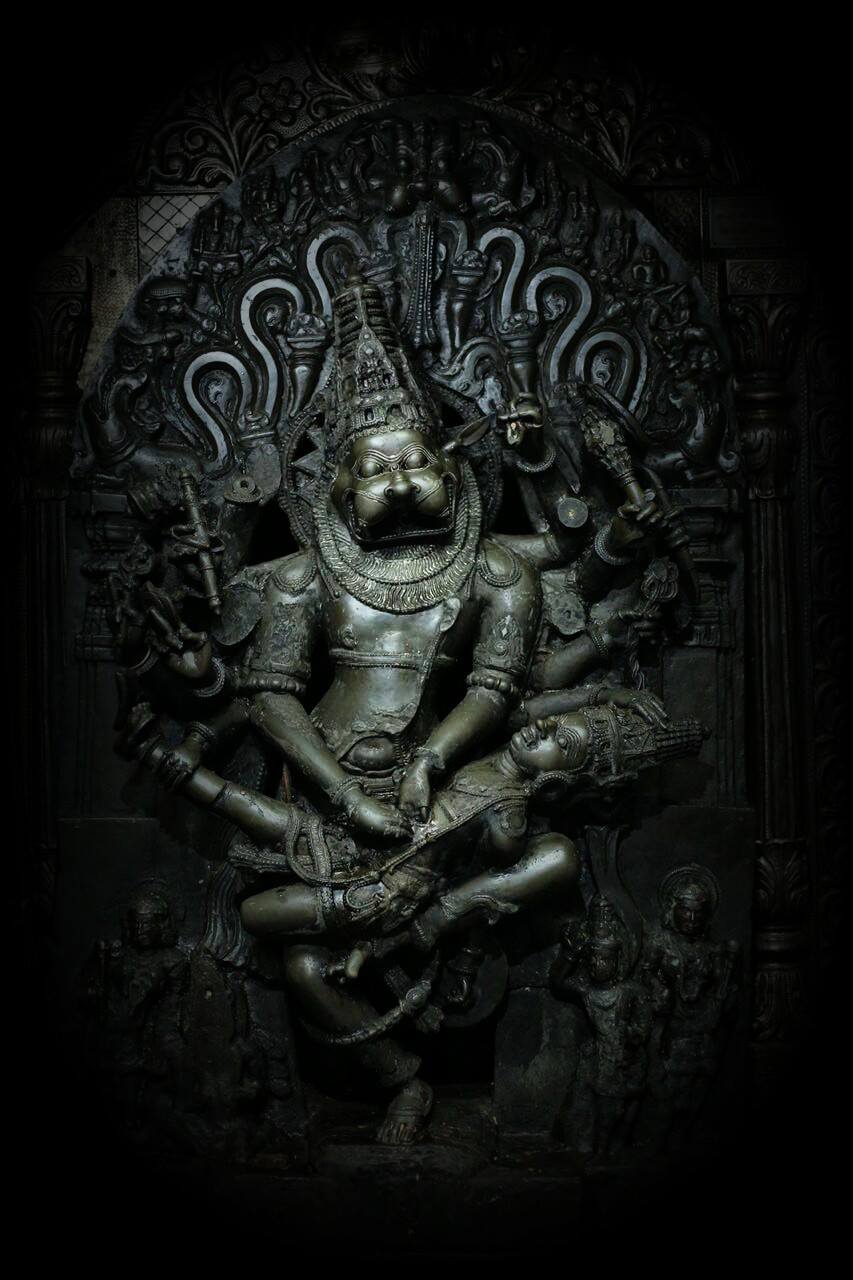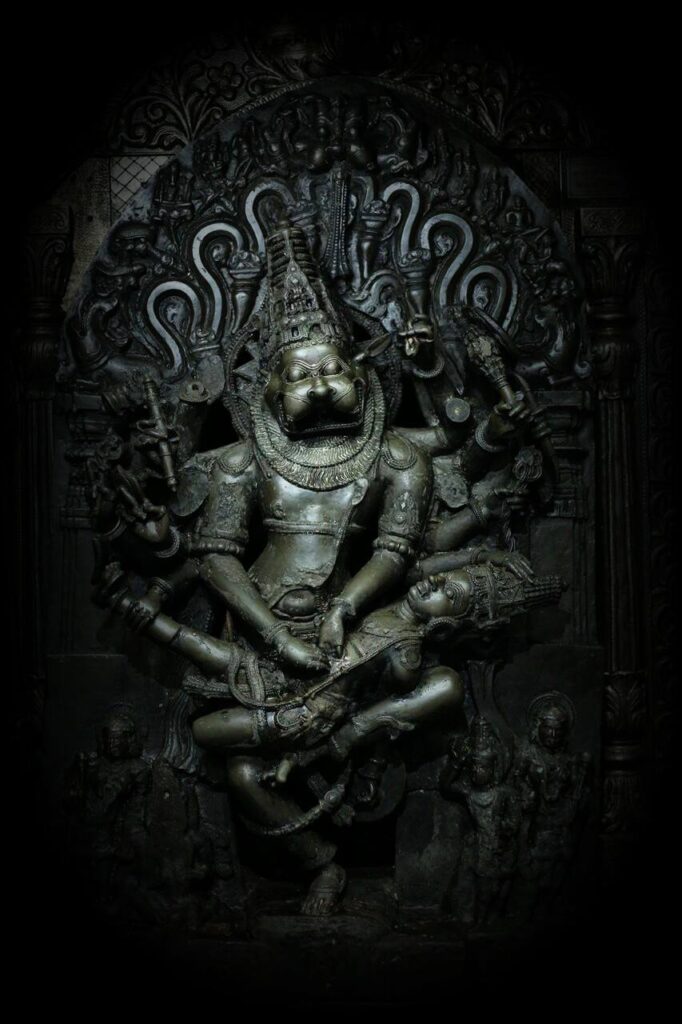
Kole Narsingpur host’s the biggest Shaligram Deity in the world. Dubbed as ‘The Underground Temple’, it is dedicated to Sri Jwala Narasimha, Whose most ferocious form resides here. Located on the banks of the sacred Krishna river amidst the lush greenery of the Walwa village in Sangli district of Maharashtra (India), the temple is equated to the original appearance site of Lord Narasimha in present day Multan (Pakistan).
Being ‘Vishnurupi’, there cannot be a better location for the temple than the banks of the Krishna river with its pristine and sparkling waters flowing half-circle around it. It is the perfect setting for a transcendental poem.
At Kole Narsingpur, the Krishna river flows southward. On the southern bank of the river sits the Ramalinga, a Shivalinga consecrated by Lord Rama. Once, while Lord Rama was in deep meditation, Bhakta Hanuman interrupted the flow of water here with his mighty arms. This was done to prevent any disturbance to his dear Lord Rama due to the flowing river water.
This resulted in the bifurcation of the river at the same place. Later, Swami Ramdas consecrated a deity of Bhakta Hanuman there and named him Bahe Hanuman. ‘Bahe’ implies mighty arm.
Sage Parashara’s strict penances here led to the appearance of the Jwala Narasimha Deity. His appearance here is also meant to assure the protection of His devotees.
Chhatrapati Shahu Maharaj had given land to the temple around 1718 CE in order to carry out its festivals and worship. Badshah Adilshah of Bijapur Sultanate too have given grants of land.
Vedic History of Kole Narsingpur
 The place where the Jwala Narasimha temple stands was once the southern part of Satara city, earlier known as Saptarishi. Sage Vashishta had lived here. The ashram of Sage Bhrigu was at the nearby Bhuinj village.
The place where the Jwala Narasimha temple stands was once the southern part of Satara city, earlier known as Saptarishi. Sage Vashishta had lived here. The ashram of Sage Bhrigu was at the nearby Bhuinj village.
The ashram of Sage Parashara, known as the Parashara Gad, used to be at the site of the Panhala fort. Sage Dhaumya lived here too and once narrated the Ramayana to the Pandavas here.
Sage Parashara used to perform penances in Kole Narsingpur before the appearance of Lord Jwala Narasimha there. The lila of the appearance of the Lord is written in a book called Krishna Mahatmya. The following verse pens down the mood of Sage Parashara here:
यदा पुनस्तदा भक्त्या तपः कर्तुं पराशरः |
नारसिंहं तदा ध्यायन् कृष्णा तीरे मुनीश्वरः ||
“The foremost amongst the sages, Parashara, performed austerities on the bank of the river Krishna with a heart full of devotion, meditating on Lord Narasimhadev.”
Around 7500 years ago, being pleased with the pure devotion of Sage Parashara, Lord Narasimha appeared as a 16-armed Shaligrama Deity with flames coming out from His lotus mouth. This was the fiercest Jwala Narasimha form ever seen. Seeing that it wasn’t possible for anyone including the Sage to establish the Deity anywhere, Lord Jwala Narasimha ordered him to immerse the Deity in the Krishna river. Sage Parashara did the same with a heavy heart.
Many centuries later, around 178 CE, a brahmin couple had become blind and dumb by the curse of a Sage. After being cursed by the Sage, they realized their folly and begged forgiveness from the Sage. He advised the couple to perform penances for the pleasure of Lord Narasimha.
Lord Narasimha Desires to Appear at Kole Narsingpur
After 12 years of rigorous penances, Lord Narasimha appeared in the dream of the brahmin couple and told them that He desired to appear on earth as a Deity and that He was present in the same form at the bottom of the sacred Krishna river. Lord Narasimha told the couple to inform the same to King Bhimadeva of Koudinyapur.
When the couple asked the Lord as to how they would find the Deity beneath river Krishna, Lord Narasimha advised them to place Kusha grass on its waters. While floating, when the Kusha grass catches fire, the Deity would be present exactly beneath the area of the grass.
After saying so, Lord Narasimha disappeared. Followed by the darshan of Lord Narasimha in their dream, the brahmin couple regained their eyesight and power of speech. They immediately set-off to meet King Bhimadeva to inform him of the orders of Lord Narasimha.
Jwala Narasimha Deity is Found
After hearing from the brahmin couple the narration of the events and the orders of Lord Narasimha, the King sent his entourage to discover the Deity. The entourage did exactly, as instructed by Lord Narasimha and hence, met with success. They discovered an extremely beautiful Shaligrama Deity of Lord Narasimha.
While taking the Deity to the capital of King Bhimadeva, the chariot broke down. Lord Narasimha said that He would not leave the banks of the Krishna river. Hence, the deity was consecrated on the banks of the Krishna river with all the Vedic rites and opened for darshan to everyone.
As per the temple pujaris, three more Deities were found beneath the river. They were all consecrated in nearby villages.
Reference to temple antiquity
Adhyaya 15 of Sri Gurucharitra says that Yadusheth, the sixth predecessor of Sant Namdev came from his original place Rile and lived here worshipping Lord Jwala Narasimha. Four to five generations of his line lived here but left just before the birth of Sant Namdev in 1124 CE.
Deities of Kole Narsingpur
The mesmerizing Deity of Lord Jwala Narasimha at Kole Narsingpur is the world’s largest Shaligrama deity and the world’s most ferocious Jwala Narasimha deity. He possesses sixteen arms and is seen tearing the stomach of Hiranyakashipu with two of His lotus hands.
The left lotus leg of Lord Narasimha is raised and bent in order to place Hiranyakashipu on it. Also, it is to hold Hiranyakashipu’s left arm to prevent him from escaping. The other foot is placed on the demon’s doorstep.
Bhakta Prahalada and Mahalakshmi Devi are present at the left bottom of the Lord. To the right of the Lord is present Bhudevi and Garudadeva. Various ornaments like the ‘Bajubandh’ are present on His lotus arm. There are rings which enhance His beauty.
Most of His lotus hands are holding various weapons. The Dashavataras can be seen carved over the non-body areas of the deity.
Other Deities of Kole Narsingpur
The Deity of Mahalakshmi Devi is present on the way to the sanctum of Lord Jwala Narasimha. In the main hall of the temple above the sanctum, there are deities of Lord Vitthala, Sri Lakshmi Narayana, Sri Gajalakshmi, and Ambabai. The samadhi of Siddha-Mahatma Siddheshwar Maharaj is present in the same hall. He was the Guru of the Kolhapur royal family.
Architecture of Kole Narsingpur Temple
This temple, in its current form, was built by Hemadri Pant on the orders of Ramdevray Yadav Devgiri in 1273 CE. The entire structure is made of huge stone blocks carefully stacked on each other. The colourful doors of the temple are made of wood. The temple sports a colourful Shikhara too.
You have to enter the temple complex through the Mahadwar which is a decently big structure built with stone blocks. Further, the Deity is accessed by two entrances. One is the northern entrance and the other is the eastern entrance preferred by most devotees.
The Dindi Darwaza is the second entrance which takes you through the main hall and then down to the sanctum. There are three levels in the temple i.e. lower, middle and upper levels.
The Garbagriha i.e. sanctum is present 14 feet beneath the ground. You have to climb down nine steps passing through some narrow tunnels which are a few feet under the flowing waters of the Krishna river.
A small opening in the ceiling of the lower level takes you to the middle level. It is accessible by one person at a time. Further on, it leads to a large hall with some deities, padukas and photos.
Overall, the temple architecture feels exciting due to its maze-like structure. It can give you the feeling of playing hide-n-seek with none other than the Supreme Thief!
Festivals of Kole Narsingpur
The main festival celebrated here is the Narasimha Jayanthi. The Swathi Nakshatra day is very special too.
Temple Timings of Kole Narsingpur
The temple remains all throughout the year, every day from 7 am to 12:30 pm and 4 pm to 8 pm.
How to Reach Kole Narsingpur
The best way to visit Kole Narsingpur hassle-free is by joining the Pandharpur Nashik Yatra conducted by Tirtha Yatra. You’ll have no regrets!
Below are some of the best options to reach Kole Narsingpur in Maharashtra –
By Road: Kole Narsingpur is nearer to urban centers like Karad, Sangli and Kolhapur. The route to Kolhapur itself is an expressway. You can easily reach the temple by road from these cities using state or private bus services after you arrive there by train or bus. You can hire a taxi too.
By Rail: Karad, Sangli and Kolhapur are the nearest stations connected to the rest of India. Karad Railway Station is the nearest at a distance of 25 km. You can alight here and catch a bus, autorickshaw or taxi to Kole Narsingpur.
By Air: Pune Airport 191 km away and Kolhapur Airport 66 km away are the nearest operational airports. You can fly in here and use the rail or road route to reach Kole Narsingpur.
PS: Kolhapur Airport has services to Bengaluru, Hyderabad and Tirupati only, as of now. Once the airport upgradation is complete, you can fly in here from more cities across India.
Kole Narsingpur: World’s Biggest Shaligram Deity
Lord Jwala Narasimha resides on the banks of the serene and sacred Krishna river surrounded by scenic natural beauty for His own pleasure and to remind His devotees of the importance of simple living and high thinking. While the Lord was performing His lilas all along, He had been indicating His desire to stay near His devotees receiving their love and protecting them.
Also, residing near His devotee, the serene and sacred Krishna river, keeps Him calm. This huge river serves as the only Tirtha for the temple. Such that, abhishekam i.e. ceremonial bathing of the Lord is done by the pujaris standing in the pristine waters of the river.
Though the world’s largest Shaligram Deity, He remains out of the limelight for reasons best known to Him. Maybe, you could visit Him, get His blessings and bring Him to the limelight!
Jaya Narasimhadev!
4










4 Comments On Kole Narsingpur
Abee
Hare Krishna , thank you very much for share. Jay Lord Narasimha.
Surender
Thanks a lot for your writing this article.. Hope are Blessed with Divine Grace and having Mercy of Lord Narshimha Swami. It is a wonderful feeling after reading your article.
Girija Sawkar
Please add me to your listings… thank you
Surender
“Thank you very much for writing such a wonderful article. I hope you have the divine grace and mercy of Lord Narasimha Swami.”